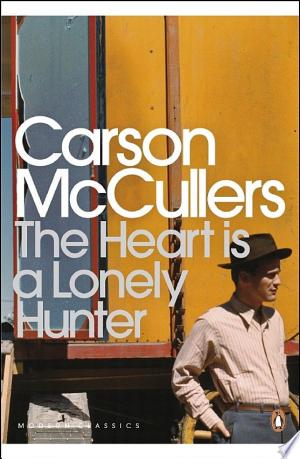Estimated read time: 6 min read
One Sentence Summary
A deaf-mute man becomes the confidant for a group of lonely individuals in a small Southern town.
Table of Contents
Introduction
"The Heart is a Lonely Hunter" is a timeless classic written by Carson McCullers. This novel, first published in 1940, is a poignant and insightful exploration of loneliness, friendship, and the human condition. Set in a small Southern town during the 1930s, the story delves deep into the lives of its characters, each struggling with their own inner turmoil and yearning for connection.
Brief Synopsis
Plot Overview
The novel is set in the town of Mill Town, Georgia, during the 1930s. The narrative revolves around a deaf-mute man named John Singer, who becomes a confidant to a diverse group of individuals, including a young girl named Mick Kelly, an African American doctor named Dr. Benedict Copeland, an alcoholic named Jake Blount, and a widowed cafe owner named Biff Brannon. As these characters interact with Singer, they reveal their innermost thoughts and desires, seeking solace and understanding in their respective struggles.
Setting
The setting of the novel, Mill Town, Georgia, is a small town in the American South during the 1930s. The town is characterized by its close-knit community, racial tensions, and economic hardships resulting from the Great Depression. These elements play a significant role in shaping the experiences and interactions of the characters.
Main Characters
The Heart is a Lonely Hunter features a range of compelling characters, each grappling with their own internal battles and quests for connection.
| Character | Description |
|---|---|
| John Singer | A deaf-mute man who becomes a confidant to various individuals in the town. He is a central figure around whom the other characters revolve, providing a sympathetic ear and emotional support. |
| Mick Kelly | A young girl who harbors aspirations of music and art. She is introspective and yearns for beauty and self-expression amidst the challenges of her impoverished upbringing. |
| Dr. Benedict Copeland | An African American doctor who is deeply troubled by the racial injustices and societal inequalities prevalent in the town. He is driven by a fervent desire to uplift his community and advocate for social change. |
| Jake Blount | An alcoholic and transient worker who is passionate about political activism. He grapples with his inner demons and seeks to rally others against the oppressive forces he perceives in society. |
| Biff Brannon | The widowed owner of a local café, Biff Brannon is observant and introspective. He finds himself drawn to the lives of others, often pondering their struggles and seeking to understand the human condition through his interactions. |
Story Points Over Chapters
Chapter 1-5: Introducing the Characters
The narrative introduces the characters and their individual struggles. John Singer's arrival in town sets the stage for the subsequent interactions and relationships that develop among the main characters.
Chapter 6-10: Unveiling Inner Turmoil
The characters begin to confide in John Singer, sharing their deepest fears and desires. Mick Kelly's passion for music and art, Dr. Copeland's activism, Jake Blount's political fervor, and Biff Brannon's observations of human nature are all unveiled.
Chapter 11-15: Interwoven Lives
The lives of the characters become increasingly intertwined as they seek solace and connection through their interactions with John Singer. Their yearnings for understanding and emotional support drive the narrative forward.
Chapter 16-20: Conflicts and Tensions
Racial tensions, societal inequalities, and personal conflicts come to the forefront, testing the characters' resilience and challenging their beliefs. Dr. Copeland's fervent activism and Mick Kelly's struggles with poverty and artistic aspirations add layers of complexity to the story.
Chapter 21-25: Resilience and Despair
The characters grapple with moments of resilience and despair, with their individual journeys taking poignant turns. Their interactions with John Singer serve as a source of comfort and introspection amidst the challenges they face.
Chapter 26-30: Culmination of Relationships
The relationships among the characters reach a critical juncture, with their intertwined lives converging in unexpected ways. Their connections with John Singer and each other lead to moments of revelation and emotional impact.
Main Events
- John Singer's arrival in town and his subsequent interactions with the main characters
- Mick Kelly's aspirations and struggles with poverty
- Dr. Copeland's activism and his efforts to advocate for social change
- Jake Blount's political fervor and battles with alcoholism
- Biff Brannon's observations of human nature and his connection to the lives of others
- The characters' evolving relationships and the impact of their interactions with John Singer
Themes and Insights
Loneliness and Connection
The novel deeply explores the theme of loneliness and the universal human need for connection. Through the characters' interactions with John Singer, the narrative sheds light on the profound impact of genuine emotional support and understanding.
Identity and Aspiration
The characters' quests for self-expression, social change, and personal fulfillment underscore the themes of identity and aspiration. Mick Kelly's artistic yearnings, Dr. Copeland's activism, and Jake Blount's political ardor all reflect the human desire to pursue one's passions and make a meaningful impact.
Racial Injustice and Inequality
The novel addresses the pervasive racial injustices and societal inequalities prevalent in the town, as seen through Dr. Copeland's fervent advocacy and the characters' encounters with discrimination. These themes provide poignant commentary on the challenges faced by marginalized communities.
Reader's Takeaway
"The Heart is a Lonely Hunter" offers readers a profound exploration of the human experience, delving into the complexities of loneliness, connection, and the pursuit of meaning. Through its richly drawn characters and evocative storytelling, the novel provides insights into the resilience of the human spirit and the enduring power of empathy and understanding.
Conclusion
In conclusion, "The Heart is a Lonely Hunter" stands as a timeless work that continues to resonate with readers for its poignant portrayal of human longing, the intricacies of relationships, and the enduring quest for connection. Carson McCullers' masterful storytelling and rich character development offer a compelling narrative that invites readers to contemplate the depths of the human heart and the transformative power of empathy.
The Heart is a Lonely Hunter FAQ
What is 'The Heart is a Lonely Hunter' about?
The novel follows a deaf-mute man named John Singer and his interactions with various residents in a small Southern town. It explores themes of loneliness, isolation, and the human need for understanding and connection.
Who is the author of 'The Heart is a Lonely Hunter'?
The author of 'The Heart is a Lonely Hunter' is Carson McCullers, an American writer known for her exploration of the spiritual isolation of misfits and outcasts in the South.
When was 'The Heart is a Lonely Hunter' first published?
The novel was first published in 1940.
What are some of the major themes in 'The Heart is a Lonely Hunter'?
Some of the major themes in the novel include loneliness, friendship, the search for meaning, the struggle for understanding, and the complexities of human relationships.
Is 'The Heart is a Lonely Hunter' based on a true story?
No, the novel is a work of fiction and is not based on a true story.
What is the significance of the title 'The Heart is a Lonely Hunter'?
The title is taken from a poem by William Sharp and reflects the central theme of the novel, which is the universal experience of longing and the human need for connection.





